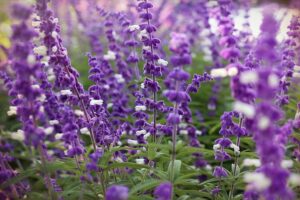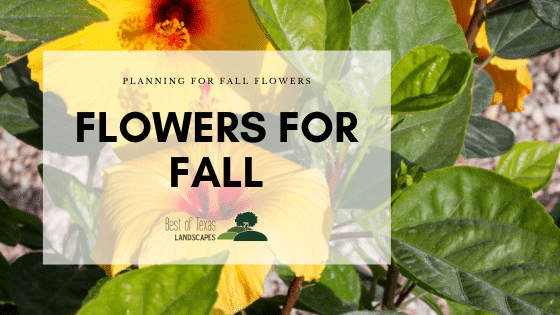What’s one thing Texas homeowners take pride in? Along with our homes, we take great satisfaction in the trees, garden beds and other landscaping that adds something special and beautiful to our property. Attractive landscaping adds curb appeal and increases property value, and it makes spending time outdoors that much more enjoyable.
If you’re a newcomer to the state, you might not realize gardening in Texas isn’t just for springtime. With a little know-how and planning, you can indeed, enjoy fresh, colorful blooms almost any time of year.
The start of school and fall activities usually bring with them cooler temperatures, which is a good excuse to work in your yard and garden. Take stock of your plants and see which ones may have withered in the Texas summer sun and will need to be replaced. Fall is also a good time to determine where you might want to start a new flower bed. Getting your flowers started early in the season can help them become established before winter weather arrives.
After you determine where you want your flowers to go and how many you’ll need, the next step is to decide which types of flowers would work best for your yard. Read on to learn more about flowers which are well-suited to Texas and under what conditions they will thrive.
CORNFLOWERS
 Also known as blue-bottles and bachelor’s buttons, these plants can add a pretty pop of blue to your garden from autumn through winter and into spring. Cornflowers do well in full sun, spaced two or three feet apart in your garden bed or planter.
Also known as blue-bottles and bachelor’s buttons, these plants can add a pretty pop of blue to your garden from autumn through winter and into spring. Cornflowers do well in full sun, spaced two or three feet apart in your garden bed or planter.
Late September is a good time for sowing cornflower seeds outdoors. You can also sow them indoors about a month before you plan to plant them outside, sowing a quarter-inch deep, three to four seeds per pot, and then snipping off all but the strongest plants. When your seedlings have reached between two and four inches tall, they’re ready to be transplanted to your outdoor garden.
FALL ASTERS
 Asters make a wonderful border plant for a fall or winter Texas garden. These flowers, which look like pretty purple daisies, thrive in rocky or sandy soil, and they like full sun or partial shade best.
Asters make a wonderful border plant for a fall or winter Texas garden. These flowers, which look like pretty purple daisies, thrive in rocky or sandy soil, and they like full sun or partial shade best.
Plant asters in late summer for blooms in the fall, spacing them about one-and-a-half to two feet apart. Be careful not to overwater; if you see that they’re wilting, give them a spray, but let the soil dry out between waterings.
PETUNIA
 These flowers are special because they do well in both hotter and cooler weather. You can start petunias from seeds in late winter, for outdoor planting in the spring, but you can also plant them outdoors in September for lovely autumn blooms.
These flowers are special because they do well in both hotter and cooler weather. You can start petunias from seeds in late winter, for outdoor planting in the spring, but you can also plant them outdoors in September for lovely autumn blooms.
While most petunias prefer full sun, not all varieties of petunias are the same. Certain varieties require sandy, well-drained soil, while others need to stay very moist; make sure you know which variety you’re planting in order to plan accordingly.
The Best Texas Garden Flowers For Your Yard
Perhaps you were planning to start a new garden in the spring and are ready to get started now. Maybe you want to add a small flower bed to your existing landscape. Below are some other plants you might want to consider adding to your outdoor spaces during the fall months.
CHRYSANTHEMUMS
 A flower you’ll see as the centerpiece of enormous Homecoming corsages here in Texas comes in all the typical fall colors. These can be planted in full sun in your flower bed to produce gorgeous flowers throughout the fall season. They produce their best flowers after their first year in the ground, so be patient with them. After planting chrysanthemums in the fall, keep them trimmed throughout the following year, pruning them to a rounded shape and snipping off any flower buds that form. Once the next August rolls around, stop trimming the flower buds. By October, you should have a garden full of gorgeous blooms.
A flower you’ll see as the centerpiece of enormous Homecoming corsages here in Texas comes in all the typical fall colors. These can be planted in full sun in your flower bed to produce gorgeous flowers throughout the fall season. They produce their best flowers after their first year in the ground, so be patient with them. After planting chrysanthemums in the fall, keep them trimmed throughout the following year, pruning them to a rounded shape and snipping off any flower buds that form. Once the next August rolls around, stop trimming the flower buds. By October, you should have a garden full of gorgeous blooms.
CORAL VINE
 This perennial vine does well all over Texas, but especially in the central part of the state. Native to Mexico, coral vine is a hardy grower; plant seeds or transplant a root tuber from another location, and just a handful of months later, you’ll have a mass of vines and delicate flowers. Some consider the plant invasive since it can grow rapidly and if left unchecked crowds out native species. Coral vines display their lovely, lacy tendrils of flowers in early to mid-fall, and flowers can range from white to pink to a dark rose hue.
This perennial vine does well all over Texas, but especially in the central part of the state. Native to Mexico, coral vine is a hardy grower; plant seeds or transplant a root tuber from another location, and just a handful of months later, you’ll have a mass of vines and delicate flowers. Some consider the plant invasive since it can grow rapidly and if left unchecked crowds out native species. Coral vines display their lovely, lacy tendrils of flowers in early to mid-fall, and flowers can range from white to pink to a dark rose hue.
Coral vines grow best with a trellis, arbor or fence to climb; they can also send out their curly little shoots to climb a brick or stone wall. Don’t worry when this plant dies back with the first frost, and don’t be afraid to cut it back vigorously. Come spring, it will begin its new growth cycle quickly and heartily.
Drought tolerant, coral vines thrive in partial or full sun, which makes them a perfect choice for central and south Texas gardens.
MEXICAN BUSH SAGE
 This plant’s gorgeous, lavender-hued flowers are the perfect choice for a more natural-looking garden. Fans of xeriscaping often choose this perennial for their garden designs, and it’s a great plant to share with friends, as it’s easily grown from stem cuttings.
This plant’s gorgeous, lavender-hued flowers are the perfect choice for a more natural-looking garden. Fans of xeriscaping often choose this perennial for their garden designs, and it’s a great plant to share with friends, as it’s easily grown from stem cuttings.
Mexican bush sage flowers from the end of summer until the first frost. If this plant experiences frost damage, you can cut it down to six inches tall and cover it with mulch, and it will return vigorously in the spring.
Since Mexican bush sage can grow to four or five feet across and in height, be sure to give it room in your garden. It often looks best placed at the back of a bed, as a gorgeous lavender backdrop to shorter plants in front. Be sure to prune in summer to keep it from getting too bushy by fall.
DIANTHUS
 Also called Sweet William, dianthus is a wonderful option for gardeners who need flowers that grow well in cooler temperatures. Dianthus flowers come in many shades of red, pink and white, and are best planted in an area that is shady in the afternoons. Morning sun is fine, especially since this plant is prone to fungus; sunlight helps protect against this disease.
Also called Sweet William, dianthus is a wonderful option for gardeners who need flowers that grow well in cooler temperatures. Dianthus flowers come in many shades of red, pink and white, and are best planted in an area that is shady in the afternoons. Morning sun is fine, especially since this plant is prone to fungus; sunlight helps protect against this disease.
Dianthus needs to be watered regularly, but not overwatered. Deadheading—pinching or snipping off any dead flowers just above the first set of healthy leaves—can help to encourage the growth of new blooms.
PANSIES
 These are a pretty and traditional addition to a winter garden, and they’re wonderfully easy to grow, at least in the cooler months. Since they don’t weather Texas heat well, pansies are better here as an annual than a perennial. Pansy seeds can be sown indoors in early fall in a soilless germination mixture, about an eighth of an inch deep. When kept dark and moistened regularly with a spray bottle or mister, germination should occur within two to three weeks.
These are a pretty and traditional addition to a winter garden, and they’re wonderfully easy to grow, at least in the cooler months. Since they don’t weather Texas heat well, pansies are better here as an annual than a perennial. Pansy seeds can be sown indoors in early fall in a soilless germination mixture, about an eighth of an inch deep. When kept dark and moistened regularly with a spray bottle or mister, germination should occur within two to three weeks.
Once the little shoots emerge, the plants can be moved to a cool, bright area to continue growing. When the seedlings have grown two sets of leaves, they’re ready to be transplanted to a sunny location outdoors, preferably in November. Space them about six to ten inches apart for best results.
Take The Next Step
Now that you have a better understanding of which flowers grow best in our Central Texas climate are you ready to get started? We are here to help design your landscape to enhance the look of your home.


